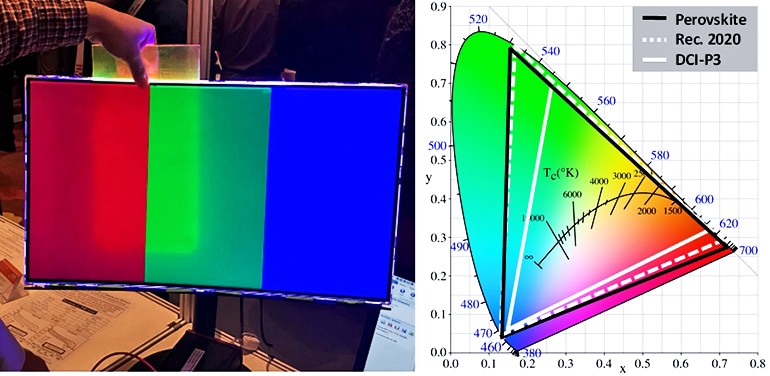Researchers have developed a color-enhancement film that could bring richer and more natural colors to next-generation flat-panel electronic displays.
Current commercial display technologies such as organic light-emitting diodes (OLED) and quantum dot light-emitting diodes (QLED) can only produce slightly more than 50 percent of the colors visible to the human eye, limiting color reproduction that the displays can achieve.
The new film could allow future display technologies to produce more than 75 percent of all visible colors, researchers say.

As reported in Advanced Materials, the technology is enabled by a semiconductor material known as perovskite, which researchers can tune to emit light strongly and efficiently in a variety of colors by changing its chemical composition.
Luminescence efficiency
To make the enhancement films, researchers mixed nanometer-sized perovskite crystals with a liquid monomer (precursor of plastics), and triggered a polymerization reaction by illuminating the mixture with white light.
This process allowed the team to fabricate a strongly luminescent perovskite-polymer composite film that possesses a threefold enhancement in luminescence efficiency compared to a conventional perovskite nanocrystal film.
The improved luminescence is a result of the increased spatial separation between the perovskite nanocrystals in the polymer composite material, which prevents channeling of energy between crystals to the defective and non-emissive ones.
This innovation allows perovskite materials to emit light more efficiently and consume less energy when deployed in a display product. The color performance could allow next-generation televisions and monitors to achieve the higher quality Rec. 2020 color standard for ultra-high definition television (UHDTV), compared to the more limited DCI-P3 standard in current displays.
Red, green, blue
In order to understand how displays produce a range of colors, it is important to first appreciate how the human eye functions.
Our eyes are able to perceive colors because of three types of cone cells that are sensitive to red, green, and blue. The different extent of stimulation of these cone cells allows us to see a myriad of colors. For instance, a combined stimulation of red and green cones will give the perception of yellow.
DNA is key ingredient in color-changing metamaterial
Perovskite offers excellent color performance because it is able to produce spectrally “purer” RGB light that is more specific in stimulating the three cone cells in our eyes. This greater control in cone stimulation allows displays to reproduce a wider range of colors that mimic what our eyes perceive in the real world.
“An added advantage is that perovskites are easy to synthesize, potentially facilitating their scale-up and reducing the production cost of displays,” says Wong Ying Chieh, research fellow of chemistry at the National University of Singapore. “The time taken for perovskite precursor chemicals to react and form nanocrystals is typically on the order of 10 seconds.”
Better light detector can see more colors
“Perovskite materials can be coated and processed in a solution form which is similar to paints, and can potentially be used in large-area displays,” adds study leader Tan Zhi Kuang, professor of chemistry.
“Although our materials are useful in enhancing the performance of televisions and mobile devices, my vision is to put them into wall-sized displays in our living or work spaces to create realistic virtual environments with rich and natural colors.”
The research team is currently working with display companies to commercialize the perovskite color-enhancement film and hopes to see the technology in consumer electronic products within the next two to three years.
Source: National University of Singapore



